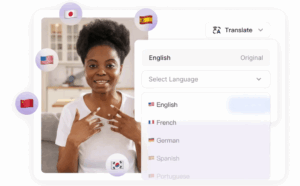Artificial Intelligence (AI) is no longer restricted to tech moguls and futurists alone but progressing into our lives quickly including education. These AI devices for teachers, on the other hand, help in different ways such as personalization of studying to assistive tasks thus allowing instructors to focus on teaching. Nevertheless, what should be done is not whether AI should be used in schools or not; instead how one can select the most appropriate among many that are truly valuable.
Table of Contents
Who Should Read This Guide?
This guide is meant for teachers and instructors who want to introduce AI in their classes but have no idea where to start from due to the numerous options available. Integrating AI into your teaching smoothly can happen if you know your needs, evaluate what has been developed so far and remain updated with new evolution.
Evaluate Your Classroom Needs
Before embarking on a search for AI tools, it’s important to look at your classroom first. The first thing you should find out is probably the challenges you are experiencing that could potentially be solved by an application of AI.

Do you have trouble personalizing lessons across diverse populations of learners? Is it possible that most of your time goes grading papers while you could just provide some feedback? Classroom management may also come up.
See Also: Why AI Tools Are Gaining Popularity in Education?
Here are a few typical areas where AI tools function best:
Personalization of Learning: Custom learning pathways made by analyzing individual students’ learning requirements using artificial intelligence systems.
Grading and Feedback: While language processing systems offer instant feedbacks concerning grammar as well as style, essay scoring software may help with marking workloads.
Administration Tasks: By automating attendance tracking, scheduling among others using AI technologies; more time shall be saved for teaching duties.
Content Creation: For example, AI can aid in producing tailored educational videos besides lesson plans as well as presentations.
Once you’ve narrowed down your areas of need, you can move forward with more specific selection criteria for your AI tool.
See Also: 10 Best AI Tools For Education
Explore the Available AI Tools

Having identified your needs, start researching on AI tools that could potentially meet those requirements. Many search engines, marketplaces and tech publications can help you get started. Some of the places to check include:
EdTech Forums and Communities: Interact with other educators who may have vetted or used some AI tools in their classes.
Conferences and Workshops: Take part in AI tools exhibit events or join webinars.
Online Marketplaces: Here, you will find platforms where you can explore various AI tools designed for teachers.
Tech Reviews and Blogs: Keep an eye out for technological review websites or educational blog sites they frequently highlight the latest and most effective AI tools.
On your research be sure to gather information about its efficiency, ease of use, compatibility options as well as cost. Additionally, it is vital to consider how the chosen AI tool aligns with your teaching philosophy and curriculum standards.
Learn more: 6 Best AI Tools For Teachers
Think about the Capabilities of the Tool’s AI
It is important to know that all AI tools are not the same, and understanding this distinction can significantly influence how effective it will be in your classroom. Below are some key considerations concerning AI capabilities.
Machine Learning: Can it refine its algorithms and predictions with time based on information it collects?
Natural Language Processing: Can it understand and generate human language for communication, grading, and content creation?
Predictive Analytics: Does it offer insights or predictions about student performance, behavior or needs?
Data Management: How does the tool handle storage and security of data as well as complying with privacy regulations such as FERPA or GDPR?
The more advanced the AI can do something, the more powerful but also difficult to integrate into current teaching practices.
See Also: Uses of AI Tools in Education
Search for Integration and Support
An independent AI tool that doesn’t fit well with other technology or systems can be a nightmare. Look out for tools that have robust APIs or better still those built to seamlessly connect with popular learning management systems (LMS) among other educational technologies. Furthermore, you should consider whether there is support from the company offering such tools.
Here are some integration and support aspects to think through:
Vendor Lock-in: Choose AI tools that work across several different systems and software so as to avoid vendor lock-in.
Training and Onboarding: Is there provision of resources, training programmes as well as support to help you learn how to use it effectively together with your students?
Response Time and Updates: Provider has regular updates indicating their responsiveness towards users’ issues which might lead them to improve.
For ease of adoption by teachers, an ideal classroom AI tool should not only be easy but also come bundled up with sufficient resources plus support services too.
Guard against Biasedness and Ethical Issues

One thing you must remember when selecting an AI tool is that they have potential biases. Learning from data means that when this data is skewed or incomplete, AI’s decisions may reflect these biases. AI tools must be vetted from diversity, equity and inclusivity perspectives.
Transparency: The tool should let people know about its learning data and processes including any limitations or possible biases.
Ethical Considerations: How does the tool address issues of student privacy, ethical standards concerning data usage and the larger implications on education by using AI?
By actively monitoring for bias and ethical concerns, you can ensure that the AI tools you bring into your classrooms contribute to a fair, just and inclusive learning environment.
See Also: What are the Potential Limitations of AI Tools in Education?
Conclusion
The decision of choosing the right AI tool for your classroom will determine how your students education would be like. Can you feel confident in your choice after understanding your needs? Researching what is available? Weighing up AI capabilities? Checking integration and support? Considering bias and ethical implications?
AI has potential to personalize education, make it more efficient and effective hence; as an educator; you can drive this change. This article provides some insight into how teachers could unlock new potentials both within their own teaching practice as well as within their pupils learning through use of appropriate technology or IT resources available today. Therefore, by being brave enough, being educated enough about advanced educational technologies like artificial intelligence (AI), you will not fear embracing future developments happening now, but rather welcome them into your daily classroom life soon!
FAQS
How do I convince my school to invest in AI tools?
Commence with explaining clearly what benefits it has separate from academic outcomes include time as well as cost savings. You may share case studies or testimonials from other schools if any that successfully used the tool.
Can AI tools replace teachers?
Teachers in their classrooms bring mentorship, emotional intelligence and personal connections to them, this makes it impossible for artificial intelligence (AI) tools to be a substitute for the same. However, they can significantly enhance teaching and allow more personalized interactions.
Are AI tools applicable for all kinds of learners?
Yes, depending on the design of the tool and its data usage. Make sure that it has been tried with different students’ groups so that all learners will benefit from such an application.
What are the privacy concerns when using AI tools in my classroom?
In addition, this is a complex area which requires making informed choices on matters relating to student data privacy. Transparent privacy policies and meeting legal standards regarding FERPA, GDPR etc., just as students do.




